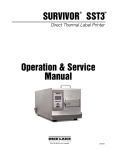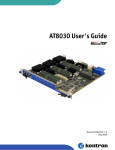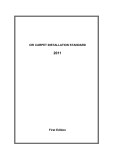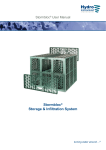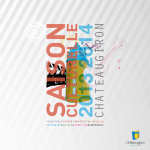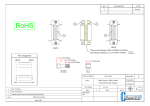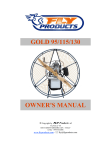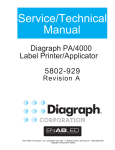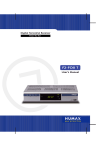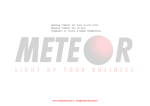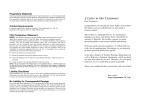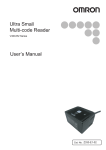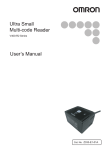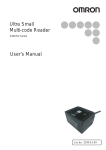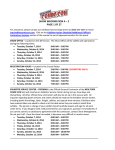Download Survivor SST2 Service Manual
Transcript
About This Manual ................................................................................................................................... 1 1.0 Introduction.................................................................................................................................. 1 2.0 General Maintenance................................................................................................................... 2 2.1 General Cleaning . . . . . . . . . . . . . . . . . . . . . . . . . . . . . . . . . . . . . . . . . . . . . . . . . . . . . . . . . . . . . . . . 2 2.2 Cleaning the Printhead. . . . . . . . . . . . . . . . . . . . . . . . . . . . . . . . . . . . . . . . . . . . . . . . . . . . . . . . . . . . 2 2.3 Cleaning the Platen Roller . . . . . . . . . . . . . . . . . . . . . . . . . . . . . . . . . . . . . . . . . . . . . . . . . . . . . . . . . 2 3.0 Parts Replacement....................................................................................................................... 3 3.1 3.2 3.3 3.4 4.0 Printhead. . . . . . . . . . . . . . . . . . . . . . . . . . . . . . . . . . . . . . . . . . . . . . . . . . . . . . . . . . . . . . . . . . . . . . Mean Time to Repair (MTTR) . . . . . . . . . . . . . . . . . . . . . . . . . . . . . . . . . . . . . . . . . . . . . . . . . . . . . . . Printhead Replacement . . . . . . . . . . . . . . . . . . . . . . . . . . . . . . . . . . . . . . . . . . . . . . . . . . . . . . . . . . . Replacement Parts List . . . . . . . . . . . . . . . . . . . . . . . . . . . . . . . . . . . . . . . . . . . . . . . . . . . . . . . . . . . Communications .......................................................................................................................... 7 4.1 4.2 4.3 4.4 Parallel Port . . . . . . . . . . . . . . . . . . . . . . . . . . . . . . . . . . . . . . . . . . . . . . . . . . . . . . . . . . . . . . . . . . . . NIC (Network Interface Card) Adapter . . . . . . . . . . . . . . . . . . . . . . . . . . . . . . . . . . . . . . . . . . . . . . . . Serial Port . . . . . . . . . . . . . . . . . . . . . . . . . . . . . . . . . . . . . . . . . . . . . . . . . . . . . . . . . . . . . . . . . . . . . Communicating to RLWS Indicators . . . . . . . . . . . . . . . . . . . . . . . . . . . . . . . . . . . . . . . . . . . . . . . . . 4.4.1 4.4.2 4.4.3 5.0 3 3 3 4 7 7 7 8 Serial String . . . . . . . . . . . . . . . . . . . . . . . . . . . . . . . . . . . . . . . . . . . . . . . . . . . . . . . . . . . . . . . . . . . . . 8 Configuring Label Format in an RLWS Indicator . . . . . . . . . . . . . . . . . . . . . . . . . . . . . . . . . . . . . . . . . . 9 Gross Weight Label Format Example . . . . . . . . . . . . . . . . . . . . . . . . . . . . . . . . . . . . . . . . . . . . . . . . . 10 Specifications ............................................................................................................................ 11 SURVIVOR® SST2 Limited Warranty ....................................................................................................... 12 Technical training seminars are available through Rice Lake Weighing Systems. Course descriptions and dates can be viewed at www.rlws.com or obtained by calling 715-234-9171 and asking for the training department. Copyright © 2004 Rice Lake Weighing Systems. All rights reserved. Printed in the United States of America. Specifications subject to change without notice. June 2004 ii SURVIVOR SST2 Installation Manual About This Manual This manual is intended for use by technicians responsible for servicing the SURVIVOR ® SST2 printer. Along with this manual, the Datamax ® I Class T M Operator’s Manual (RLWS PN 75098) accompanies the SST2 and covers operation, calibration, and in-depth maintenance of the printer. (The Datamax manual can also be viewed or d ow n l o a d e d a t t h e R LW S d i s t r i bu t o r s i t e a t www.rlws.com.) The following service procedures are intended to instruct you on how to: • Understand features and specifications of the SST2. • Perform general printer maintenance. 1.0 Warning Some procedures described in this manual require work inside the printer enclosure. These procedures are to be performed by qualified service personnel only. Authorized distributors and their employees can view or download this manual from the Rice Lake Weighing Systems distributor site at www.rlws.com. Introduction T h e S U RV I VO R ® S S T 2 l a b e l p r i n t e r i s a high-performance, high speed industrial washdown direct thermal and optional thermal transfer label printer. Features include: • Print speed of up to 8"-12" per second (203.2mm/sec.). • Common bar codes are resident in SST2 memory and can be printed with or without adjacent human readable bar code interpretations. • Character fonts can be printed in any one of four directions and with any one of nine different font sizes. In addition, a resident smooth font, called CG Triumvirate®, can be separately selected and contain 10 different font sizes. By using font multiplication, font size expands vertically and horizontally up to 24 times. • A dot-history control circuit, called SEAQTM (Sequential Energy Adjustment for Quality), enhances quality while printing at high speeds. This circuit monitors the printed data a n d a u t o m a t i c a l l y a d j u s t s t o p r ov i d e maximum printhead performance. The 0.0049 inch print element prints high-density bar codes and characters at a 203 dpi resolution. In addition, the pixel size can be multiplied by 2 in the horizontal and 3 in the vertical direction, producing larger formats. • Connects to most computers and controllers through either RS-232C or the Centronics® parallel interface. • • • • Optional memory cartridges of up to 4MB font and 4MB Flash provide storage for fonts, label formats and graphic images. Optional Ethernet for network communication. Software-selectable printhead temperature, print speed, slew rates and form dimensions provide the option of storing a wide variety of parameters, thus eliminating the need for manual adjustments. This is especially helpful when using several different types or brands of label stock, or when switching between direct thermal printing and thermal transfer printing. Configurable for “one up” printing mode. With the present sensor installed and enabled, the next label is not printed until the last label printed has been removed from the printer. Quantities of one-at-a-time can be selected. Introduction 1 2.0 General Maintenance This section describes procedures for general maintenance and cleaning of the SST2. 2.1 General Cleaning During normal operation, media debris may accumulate around the printer mechanism inside the printer (see Figure 3-3 on page 6). This debris should be removed regularly using a soft bristle brush and/or vacuum cleaner. 2.2 Cleaning the Printhead Foreign particles can collect on the printhead (see Figure 3-2 on page 5), causing characters or bar codes to appear light or faded. This type of problem is evidenced by a continuous light streak which appears in the same physical position on each printed line. This condition should only appear after extensive printer operation or if poor quality paper has been used. It is recommended that Rice Lake Weighing Systems-supplied labels are used to obtain continuous high quality printing. Recommended printhead cleaning intervals: • Due to abrasion and foreign particle deposits, direct thermal printheads should be cleaned every 50,000 linear inches (12700m). • Thermal transfer printheads should be cleaned at least every 250,000 linear inches. Printhead cleaning procedure: 1. Turn off and unplug printer from outlet. 2. Open cover. Unlock and raise printhead. 3. Gently wipe underside of printhead burn-line area using a cotton swab moistened (not soaked) with isopropyl alcohol. Allow to dry. 4. Lower and lock printhead. 5. Close cover. Plug in and turn on printer. 2 SURVIVOR SST2 Service Manual 2.3 Cleaning the Platen Roller Use the following steps to clean the platen roller of the SST2. 1. Turn off and unplug printer from outlet. 2. Open the cover. Unlock and raise the printhead assembly. 3. Use a clean cotton swab or a lint-free cloth dampened with isopropyl alcohol to wipe off all debris from the platen roller. Manually rotate the roller to clean the entire surface. Allow to dry. 4. Lower the printhead assembly and lock into position. 5. Close the cover. Plug in and turn on the printer. 3.0 Parts Replacement The following sections outline part replacement guidelines and procedures, and list replacement parts for the SURVIVOR® SST2 printer. 3.1 Printhead The SST2 uses a thin film printhead that dissipates heat faster than thick film, providing a longer head life. Printhead warranty is 500,000 linear inches with an expected life (using thermal transfer printing) of 2,000,000 linear inches. 3.2 Mean Time to Repair (MTTR) Estimated MTTR the printer is less than 15 minutes. A number of factors contribute to the ease of service. Primarily, all electronics including the power supply are located on a single plug-in circuit board. Most electronic problems can be isolated and repaired with a simple board swap. The printhead is also designed for easy replacement. One mounting screw and two locator pins eliminate the mechanical head adjustments required of other thermal label printers. 3.3 Printhead Replacement Removal: 1. Turn the printer off and unplug from the outlet. Open the media cover. 2. Loosen the printhead mounting screw. Carefully unlatch the printhead assembly and disconnect the two cables from the printhead. Replacement: 1. Reconnect the printhead cables. 2. Position the printhead on the printhead assembly and tighten the printhead mounting screw. Caution Be sure to ground yourself to the chassis before you remove or install the printhead. This prevents a static discharge from your body through the printhead to the ground. Parts Replacement 3 3.4 Replacement Parts List Part Number Description 53930 1.5" media hub assembly 53934 Flanged .375 ID x .875 OD bearing 53951 Standard cutter cable assembly 72238 Motor control cable assembly 72198 PH data cable assembly 72190 PH power cable assembly 72176 Front panel flex cable 72177 Media sensor flex cable 72237 P/S power cable 53933 Cap-Cam 53931 Media clutch assembly 53929 Ribbon clutch assembly 34911 E-ring 3/8 Truarc 5133-37 53935 24 pitch 48 teeth gear spur Delrin 53936 Gear spur Delrin, 24 teeth 53952 2 x 20 character LCD module 53955 Main board, SST2 12 ips 53940 Media sensor assembly 53928 Media take-up assembly 53909 Peel mechanism 53943 Peel/present sensor assembly 53924 Platen assembly 53923 Post idler 53942 Present sensor assembly 53939 Printhead 203 dpi dual connector 53926 Ribbon spool assembly 67797 Cover ribbon spool 53954 RS 485/RS 422, IC Trnsver, 14 pin dip 53938 Torsion spring 53941 Stepper motor assembly 53927 Ribbon supply assembly 53925 Take-up hub assembly 53937 Timing belt 72054 SST2 overlay 72053 Cover plate 74705 Base gasket 74706 Coverplate gasket 74810 Shroud gasket 80756 Main board, SST2 8 ips Table 3-1. SURVIVOR® SST2 Replacement Parts List 4 SURVIVOR SST2 Service Manual Electronics Cover Centerplate Assembly Drive Motor Figure 3-1. SST2 Side View Printhead Printhead Printhead Leveling Cam Leveling LevelingCam Cam Printhead Printhead Printhead Peel/Present Peel/Present Peel/Present Assembly Option Assembly Option Assembly Option Figure 3-2. SST2 Front View Parts Replacement 5 Thermal Transfer Assembly Cover Plate Media Rewind Assembly Print Mechanism Printhead Release Lever Options Connector Media Guide Media Sensor Figure 3-3. SST Side View 6 SURVIVOR SST2 Service Manual Media Supply Hub 4.0 Communications Using a data detection process, the interface selection occurs automatically in the printer. At power-up, the printer begins monitoring the interface ports for activity. When the host transmits data, the printer port detecting this data is set active and remains active as long as data flow continues. Once the incoming (received) data flow stops and the host timeout value is exceeded, the detection process is repeated. Should the data flow stop before a complete label format is received, the format is ignored and must be sent to the printer again. NOTE: To change an active port immediately, cycle the printer power off and on. 4.1 Parallel Port The parallel interface has two menu-selectable modes of operation: uni-directional or bi-directional. The uni-directional mode supports forward channel only communication and requires Centronics® cable with a 36-pin male connector. The bi-directional mode supports forward and reverse channel IEEE 1284 Compliant communications. Data can be returned to the host in this mode provided it has compliant hardware, supporting software and is connected to the printer via an IEEE 1284 Compliant cable with a Centronics 36 pin male connector. 4.2 NIC (Network Interface Card) Adapter The optional NIC adapter has several menu-selectable modes (see Datamax® Manual, PN 75098). The following LED indicators on the NIC adapter provide operational information: • LINK: A green LINK LED indicates a good physical connection to the network. • ACT: The ACT LED (activity) flashes green or red when the server is ready for use; green indicates activity for this IP address while red indicates collisions on the network. • 100: A green 100 LED indicates a 100 BASE-T (100 MB) network connection. The following buttons are accessible from the back of the printer: • TEST: Causes an NIC configuration label to print. • ETHERNET RESET: Resets the NIC adapter. NOTE: Following initialization, the printer indicates READY. However, the NIC adapter is not ready to receive data until its boot-up process is completed. Depending upon the NIC adapter configuration, this process may take up to two minutes to complete. 4.3 Serial Port The serial interface supports RS-232C and, if equipped, RS-422 communications. The following list of serial port settings is menu-selectable and must match the host computer’s serial port settings. • Baud rate (serial communication speed) • Word length • Word parity • Number of stop bits • Handshaking protocol In addition to the port settings, the serial interface cable wiring must have specific connections (pin-outs) for proper data exchange between the host and printer. The different serial cable pin-outs and suggested applications are shown in Figure 4-1 on page 8. Communications 7 PC (DB9P) to Printer Null Modem (MXM) PRINTER HOST 1 TXD 2 RXD 3 7 SHIELD 1 3 RXD 2 TXD GROUND 7 PC 1 TXD 3 RXD 2 PRINTER SHIELD 1 3 RXD 2 TXD 20 BUSY CTS 8 5 GROUND 7 4 4 RTS 6 4 RTS 5 5 CTS 4 5 CTS DB25P DB25P For connection to other DCE equipment. Flow control is only Xon/Xoff. PC (DB25P) to Printer PC 1 TXD 2 RXD 3 SHIELD 7 GROUND RS-422 Connection PRINTER HOST 1 3 RXD 2 TXD RXD+ RXDTXD+ TXD- 20 BUSY CTS 5 DB9S DB25P For connection to a PC compatible with DB9P communication ports. Flow control can be either Xon/Xoff or CTS/DTR. PRINTER 9 TXD+ 10 TXD18 RXD+ 19 RXD- 7 4 6 4 RTS 5 8 5 CTS DB25P 20 DB25P DB25S For connection to a PC compatible with DB25 communication ports. Flow control can be either Xon/Xoff or CTS/DTR. Figure 4-1. Serial Interface Cable Pin-outs 4.4 Communicating to RLWS Indicators To communicate from an RLWS indicator directly to the SST2, a change to the standard RS-232 output is required. The indicator must have Smart SerialTM communication or a custom serial format developed. NOTE: The following sections do not apply to the IQ plus® 310A indicator as it does not feature Smart Serial communication or custom serial format. 4.4.1 Serial String To develop the correct serial string, you first need to understand the Datamax® Programming Language (DPL) serial string. For every piece of information printed, the print format record must consist of the following three pieces of information: • A header that is fifteen characters long. The header specifies which font is used and where the data is printed. • Data to print. • Termination character (such as a carriage return). 8 SURVIVOR SST2 Service Manual Header A typical DPL serial string header consists of the following pieces of information: Data STX Definition Description Start of text Must have start of text at beginning of character stream Label Designation of label Character rotation Rotation of characters _ Font Font choice _ Horizontal rotation Horizontal (width) muliplier _ Vertical rotation Vertical (height) multiplier 000 Bar code Dependant on type of bar code selected • If printing graphics, lines, boxes, and human-readable fonts 0 through 8, these three characters are ignored, but they still must be sent to the printer as 000. • For human-readable font 9, these three characters must be a number from 001 to 010 to select a font size for the CG triumvirate smooth font. Other selections are available if downloading from RAM, flash memory modules, ROM font modules. • For bar code fonts, these three characters represent a bar code height number. Numbers ranging from 001 (or 0.01 inch) to 999 (or 9.99 inches). 1250 Row address Four characters are the vertical offset in hundredths of an inch 0200 Column Four characters are the horizontal offset in hundredths of an inch L 1–4 Table 4-1. Serial String Header Data String, Carriage Return and Execute Command After the header, a data string and a carriage return are needed for each item to be printed. Data TEXT CR E Definition Description Printed information (data string) Data to be printed (limited by range of printhead). Data string is terminated by a carriage return Carriage return Carriage return terminates data string Execute At end of label data information, execute signals the end of the label to the printer Table 4-2. Data String, Carriage Return and Execute Command 4.4.2 Configuring Label Format in an RLWS Indicator Use the following steps to configure label format in an RLWS indicator: 1. Determine the operation mode in which you are printing. This step is important to make sure the correct format is stored in gross, net or other format modes available in the indicator. 2. Create the format. Communications 9 4.4.3 Gross Weight Label Format Example The following is a format string example for a gross weight label configured in an RLWS indicator. 2 76 60 78 76 62 49 51 49 49 48 48 48 48 49 48 48 48 48 53 48 60 71 62 60 78 76 62 69 STX L < N L > 1 3 1 1 0 0 0 0 1 0 0 0 0 5 0 < G > < N L > E Figure 4-2. Simple Gross Weight Data Stream/ASCII Example 10000 LB Figure 4-3. Simple Gross Weight Label Example 10 SURVIVOR SST2 Service Manual Key In Data Stream 5.0 Specifications Printing Type Print Speed Resolution Minimum Dot Size Optional Dot Sizes Resident Fonts Character Display Bar Codes Switches Direct thermal or optional thermal transfer 2" – 12" per second (51mm – 304mm) 2" – 8" per second, SST2 in .5" programmable increments 203 dpi (8 dots/mm) 0.005" (0.127mm) square 0.010" (0.254mm); 0.015" (0.381mm) vertical, 0.010" (0.254mm) horizontal Ten alphanumeric fonts from 0.035" H – 0.64" H (0.89mm – 16.26mm) including OCR-A, OCR-B (size and character set III), and a CG Triumvirate scalable font 33.83 cpi FONT 0 at 1X, .70 cpi FONT 6 at 8X Code 39, UPC-A, UPC-E, Interleaved 2 of 5, Code 128, EAN-8, EAN-13, HIBC, Cadabar, Plessey, UPC 2 and 5 digit addendums, Code 93, Postnet, UCC/EAN Code 128, Telepen, UPS MaxiCode, FIM, PDF417, USD-8, Datamatrix, QR Code, Aztex, TLC 39, Micro PDF417, RSS Media Width Length Thickness Type Supply Roll Capacity Capacity in Rewind Mode Label Material Thermal Transfer Ribbon 1.0" – 4.65" (25.4mm – 118mm) 0.25" – 99" (6.35mm – 2514.6mm) at 100 dots per inch 0.0025" – .010" (0.0635mm – 0.254mm) Roll-fed, die-cut labels, tags, tickets, continuous forms with blackstripe sensing 8" (203mm) maximum outside diameter on standard 1 or 3" (25.4 or 76mm) core. 6250" lineal stock, 0.0065" thick 5" (127mm) maximum outside diameter on internal rewind spindle 1.5" core (38mm). 2100" lineal stock, 0.0065" thick Thermal transfer plain-coated papers, vinyl, Mylar, metalized paper, non-woven fabric, fine woven fabric, thermal-visible light-scannable paper, infrared scannable paper, thermal ticket/tag stock, thermally sensitive plastic stock Black or colored inks; 360 meters long, 4.6 microns, backcoated, ±10% label width. 1968 feet (600 meters) max Switches CANCEL, PAUSE, and FEED. Variable Head Temperature Control Communications Interfacing Parallel and IEEE RS-232C 2400, 4800, 9600, 19.2K, 28,800, or 38.4K baud Character Set ANSI ASCII character set. Word Length Selectable 7 or 8 bit data format Handshaking XON/XOFF (on receive mode only) and CTS/DTR Input Buffer Approximately 7000 bytes; XOFF is transmitted and DTR goes low when 60 bytes are available in the buffer. XON is transmitted and DTR goes high when 1000 bytes are left in the buffer Characters transmitted with no parity from the printer Electrical Input Voltage 90 - 264 VAC, 47 -63 Hz Note: The socket outlet should be installed near the equipment and be easily accessible Circuit Protection At 115V = 1.5A Slo Blo Grounding Unit must be connected to a properly grounded receptacle Power Consumption 90 watts (standby - 10 watts) UL Listed Type 4X for indoor use only Memory Modules Internal Memory Module PCB without fonts FONT/FLASH modules 4 MB addressable Font Modules Font Modules Range of Fonts Eight available ILPC, Kanji Simplified Chinese and I/O Expansion Board Environmental Operating Temperature Humidity Ventilation Dust Electromagnetic Radiation 40°F – 95°F (4°C – 35°C) 10% – 95% non-condensing Free air movement Nonconducting, non-corrosive Moderate RF fields can be tolerated Mechanical Size Weight 13.75" H x 14.125" W x 25.25" D (349.3mm H x 358.8mm W x 641.4mm D) Approximately 63 lb (28.6 kg) Specifications 11 SURVIVOR® SST2 Limited Warranty Rice Lake Weighing Systems (RLWS) warrants that all RLWS equipment and systems properly installed by a Distributor or Original Equipment Manufacturer (OEM) will operate per written specifications as confirmed by the Distributor/OEM and accepted by RLWS. All systems and components are warranted against defects in materials and workmanship for one year. RLWS warrants that the equipment sold hereunder will conform to the current written specifications authorized by RLWS. RLWS warrants the equipment against faulty workmanship and defective materials. If any equipment fails to conform to these warranties, RLWS will, at its option, repair or replace such goods returned within the warranty period subject to the following conditions: • Upon discovery by Buyer of such nonconformity, RLWS will be given prompt written notice with a detailed explanation of the alleged deficiencies. • Individual electronic components returned to RLWS for warranty purposes must be packaged to prevent electrostatic discharge (ESD) damage in shipment. Packaging requirements are listed in a publication, Protecting Your Components From Static Damage in Shipment, available from RLWS Equipment Return Department. • Examination of such equipment by RLWS confirms that the nonconformity actually exists, and was not caused by accident, misuse, neglect, alteration, improper installation, improper repair or improper testing; RLWS shall be the sole judge of all alleged non-conformities. • Such equipment has not been modified, altered, or changed by any person other than RLWS or its duly authorized repair agents. • RLWS will have a reasonable time to repair or replace the defective equipment. Buyer is responsible for shipping charges both ways. • In no event will RLWS be responsible for travel time or on-location repairs, including assembly or disassembly of equipment, nor will RLWS be liable for the cost of any repairs made by others. THESE WARRANTIES EXCLUDE ALL OTHER WARRANTIES, EXPRESSED OR IMPLIED, INCLUDING WITHOUT LIMITATION WARRANTIES OF MERCHANTABILITY OR FITNESS FOR A PARTICULAR PURPOSE . N EITHER RLWS NOR DISTRIBUTOR WILL, IN ANY EVENT, BE LIABLE FOR INCIDENTAL OR CONSEQUENTIAL DAMAGES. RLWS AND BUYER AGREE THAT RLWS’S SOLE AND EXCLUSIVE LIABILITY HEREUNDER IS LIMITED TO REPAIR OR REPLACEMENT OF SUCH GOODS. IN ACCEPTING THIS WARRANTY, THE BUYER WAIVES ANY AND ALL OTHER CLAIMS TO WARRANTY. SHOULD THE SELLER BE OTHER THAN RLWS, THE BUYER AGREES TO LOOK ONLY TO THE SELLER FOR WARRANTY CLAIMS. NO TERMS, CONDITIONS, UNDERSTANDING, OR AGREEMENTS PURPORTING TO MODIFY THE TERMS OF THIS WARRANTY SHALL HAVE ANY LEGAL EFFECT UNLESS MADE IN WRITING AND SIGNED BY A CORPORATE OFFICER OF RLWS AND THE BUYER. © 2004 Rice Lake Weighing Systems, Inc. Rice Lake, WI USA. All Rights Reserved. RICE LAKE WEIGHING SYSTEMS • 230 WEST COLEMAN STREET • RICE LAKE, WISCONSIN 54868 • USA 12 SURVIVOR SST2 Service Manual
















